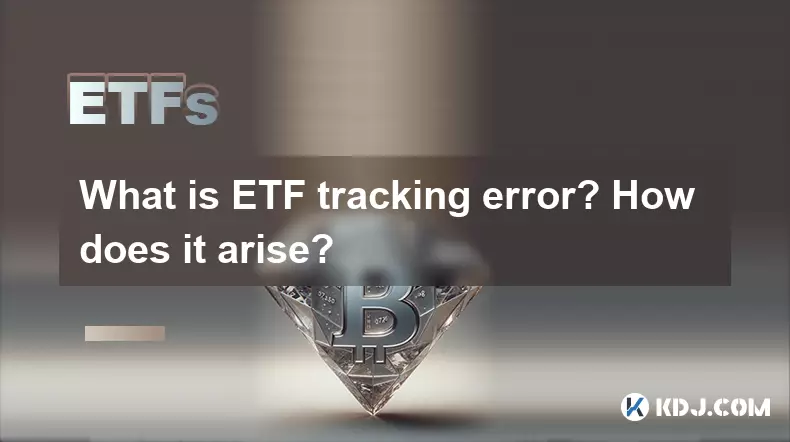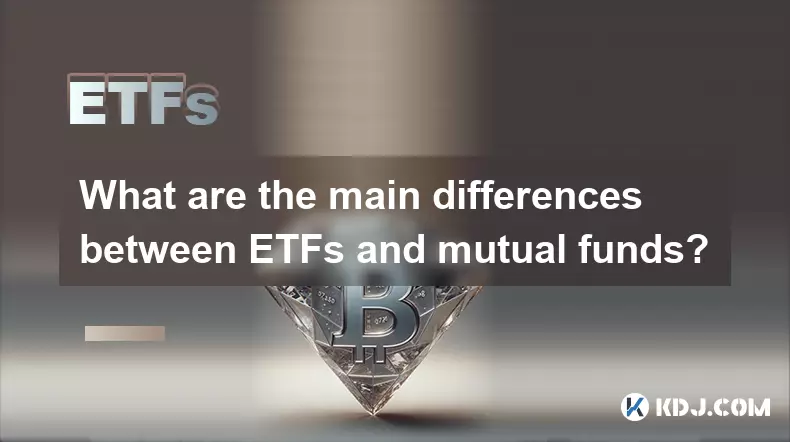-
 bitcoin
bitcoin $109667.069529 USD
-3.03% -
 ethereum
ethereum $3936.685804 USD
-4.07% -
 tether
tether $1.000493 USD
0.01% -
 xrp
xrp $2.771823 USD
-4.74% -
 bnb
bnb $957.805027 USD
-5.34% -
 solana
solana $196.735100 USD
-6.68% -
 usd-coin
usd-coin $0.999727 USD
-0.01% -
 dogecoin
dogecoin $0.227355 USD
-5.12% -
 tron
tron $0.335205 USD
-0.81% -
 cardano
cardano $0.779256 USD
-3.59% -
 ethena-usde
ethena-usde $0.999900 USD
-0.06% -
 hyperliquid
hyperliquid $42.492095 USD
-6.61% -
 chainlink
chainlink $20.501853 USD
-4.34% -
 avalanche
avalanche $28.952606 USD
-11.21% -
 stellar
stellar $0.356038 USD
-3.93%
What is ETF tracking error? How does it arise?
Tracking error in crypto ETFs—caused by fees, rebalancing delays, and custody challenges—measures how closely the fund follows its benchmark, impacting investor returns.
Sep 20, 2025 at 03:18 am

Understanding ETF Tracking Error in the Cryptocurrency Market
1. Exchange-traded funds (ETFs) have become a significant bridge between traditional finance and the digital asset space, especially as crypto-based ETFs gain regulatory traction. Tracking error measures the deviation between an ETF’s performance and its underlying benchmark index. In the context of cryptocurrency ETFs, this could mean the difference in returns between a Bitcoin ETF and the actual price movements of Bitcoin over a given period.
2. This discrepancy is not just a minor statistical nuance; it directly affects investor returns. A high tracking error suggests that the fund is not effectively mirroring its target index, which can mislead investors expecting passive exposure. For example, if a Solana ETF underperforms the Solana spot price consistently, the tracking error is substantial, indicating inefficiencies in replication strategy or operational friction.
3. The calculation of tracking error typically involves analyzing the standard deviation of the difference in daily returns between the ETF and its benchmark over time. While some variation is expected due to fees and rebalancing, persistent divergence raises concerns about fund management quality and structural design.
Primary Causes of Tracking Error in Crypto ETFs
1. One major source of tracking error stems from management fees and operational expenses. These costs are deducted from the fund’s assets, reducing net returns even if the underlying assets perform well. In the volatile crypto market, where price swings can be extreme, even small fee differentials accumulate quickly, leading to noticeable gaps in performance.
2. Another factor is the timing and frequency of portfolio rebalancing. Unlike traditional indices with predictable components, crypto indexes may include tokens with rapidly changing market caps and liquidity profiles. If the ETF does not adjust its holdings frequently enough, it risks holding outdated weights, causing slippage against the benchmark.
3. Replication methods also play a crucial role. Some ETFs use physical replication, meaning they directly hold the cryptocurrencies in their portfolio. Others rely on derivatives like futures contracts, particularly when direct custody is restricted by regulation. Futures-based Bitcoin ETFs, for instance, must roll contracts periodically, which introduces contango or backwardation effects—market conditions where future prices are higher or lower than spot prices—leading to return distortions.
4. Custody challenges add another layer of complexity. Secure storage of digital assets involves cold wallets, multi-signature protocols, and insurance mechanisms, all of which incur costs and potential delays. Any disruption in custody operations can delay trades or settlements, contributing to performance lags.
Market Structure and Liquidity Impacts
1. The fragmented nature of cryptocurrency exchanges influences how closely an ETF can track its index. Arbitrage opportunities exist across platforms, but execution speed and withdrawal limits can prevent ETF managers from capturing optimal prices. This results in acquisition costs that differ from the theoretical index value.
2. Low liquidity in certain altcoin markets exacerbates tracking issues. If an ETF includes lesser-known tokens with shallow order books, buying or selling large positions can move the market, leading to slippage. This impact is magnified during periods of high volatility or sudden inflows/outflows from the fund itself.
3. Regulatory restrictions in various jurisdictions may limit access to specific exchanges or assets. For example, a global crypto index might include tokens banned in certain countries, forcing the ETF provider to substitute or exclude them. Such deviations inherently increase tracking error.
4. Tax treatment and reporting requirements also influence fund behavior. In some regions, frequent trading triggers capital gains taxes at the fund level, which erodes returns. Managers may reduce turnover to minimize tax liabilities, inadvertently widening the gap between fund and index performance.
Frequently Asked Questions
What is considered a normal level of tracking error for a cryptocurrency ETF?A tracking error below 1% annually is generally acceptable for well-managed crypto ETFs. However, newer or niche products, especially those based on volatile altcoins or using synthetic structures, may exhibit errors exceeding 3%, which investors should scrutinize carefully.
Can tracking error be negative?Yes, tracking error can appear negative when the ETF outperforms its benchmark. This might occur due to favorable derivative positions, income from lending staked assets, or superior execution in illiquid markets. However, consistent outperformance often signals structural differences rather than efficient tracking.
Do actively managed crypto ETFs have higher tracking errors?By design, actively managed ETFs aim to deviate from benchmarks to generate alpha, so their tracking error is naturally higher. Investors should distinguish between intentional deviation for performance enhancement and unintended error due to poor execution or cost leakage.
How do investors monitor tracking error in real time?Most ETF issuers publish daily NAV (Net Asset Value) reports alongside market prices. Investors can compare these values with the underlying index levels, calculate return differences, and assess consistency. Financial data platforms also provide historical tracking error metrics for comparative analysis.
Disclaimer:info@kdj.com
The information provided is not trading advice. kdj.com does not assume any responsibility for any investments made based on the information provided in this article. Cryptocurrencies are highly volatile and it is highly recommended that you invest with caution after thorough research!
If you believe that the content used on this website infringes your copyright, please contact us immediately (info@kdj.com) and we will delete it promptly.
- Serie A Fantasy Football: Round 25 - Your Winning Picks!
- 2025-09-26 22:25:13
- Ethereum Liquidations & MAGAX Presale: Navigating Crypto's Choppy Waters
- 2025-09-26 22:25:13
- BlockchainFX: Why Whales Are Diving into This Crypto Presale
- 2025-09-26 22:30:01
- BNB, Hyperliquid, BlockchainFX: Navigating the Crypto Landscape in 2025
- 2025-09-26 22:30:01
- MIRA Price Surges Amid Binance Campaign and Mainnet Launch: What's the Buzz?
- 2025-09-26 22:30:01
- Cipher Mining, Convertible Notes, and Prices: Decoding the Crypto Landscape
- 2025-09-26 22:30:15
Related knowledge

How do I evaluate an ETF?
Sep 22,2025 at 11:18am
Evaluating the Fundamentals of an ETF1. Examine the underlying index the ETF tracks to understand its investment focus. Whether it follows a broad mar...

What is ETF tracking error? How does it arise?
Sep 20,2025 at 03:18am
Understanding ETF Tracking Error in the Cryptocurrency Market1. Exchange-traded funds (ETFs) have become a significant bridge between traditional fina...

What factors determine ETF liquidity?
Sep 26,2025 at 05:00pm
Understanding ETF Liquidity Drivers1. The underlying assets of an ETF play a crucial role in determining its liquidity. When the securities within the...

How do I understand the creation and redemption mechanisms of an ETF?
Sep 20,2025 at 10:37am
Understanding the Structure of ETFs in the Cryptocurrency Market1. Exchange-traded funds (ETFs) have become a significant bridge between traditional f...

What are the main differences between ETFs and mutual funds?
Sep 21,2025 at 06:01pm
Differences in Structure and Trading Mechanism1. Exchange-traded funds (ETFs) are traded on stock exchanges just like individual stocks, allowing inve...

ETF Investing Primer: What are exchange-traded funds?
Sep 21,2025 at 01:00pm
Understanding Exchange-Traded Funds in the Cryptocurrency Space1. Exchange-traded funds (ETFs) have become a bridge between traditional financial inst...

How do I evaluate an ETF?
Sep 22,2025 at 11:18am
Evaluating the Fundamentals of an ETF1. Examine the underlying index the ETF tracks to understand its investment focus. Whether it follows a broad mar...

What is ETF tracking error? How does it arise?
Sep 20,2025 at 03:18am
Understanding ETF Tracking Error in the Cryptocurrency Market1. Exchange-traded funds (ETFs) have become a significant bridge between traditional fina...

What factors determine ETF liquidity?
Sep 26,2025 at 05:00pm
Understanding ETF Liquidity Drivers1. The underlying assets of an ETF play a crucial role in determining its liquidity. When the securities within the...

How do I understand the creation and redemption mechanisms of an ETF?
Sep 20,2025 at 10:37am
Understanding the Structure of ETFs in the Cryptocurrency Market1. Exchange-traded funds (ETFs) have become a significant bridge between traditional f...

What are the main differences between ETFs and mutual funds?
Sep 21,2025 at 06:01pm
Differences in Structure and Trading Mechanism1. Exchange-traded funds (ETFs) are traded on stock exchanges just like individual stocks, allowing inve...

ETF Investing Primer: What are exchange-traded funds?
Sep 21,2025 at 01:00pm
Understanding Exchange-Traded Funds in the Cryptocurrency Space1. Exchange-traded funds (ETFs) have become a bridge between traditional financial inst...
See all articles










































































